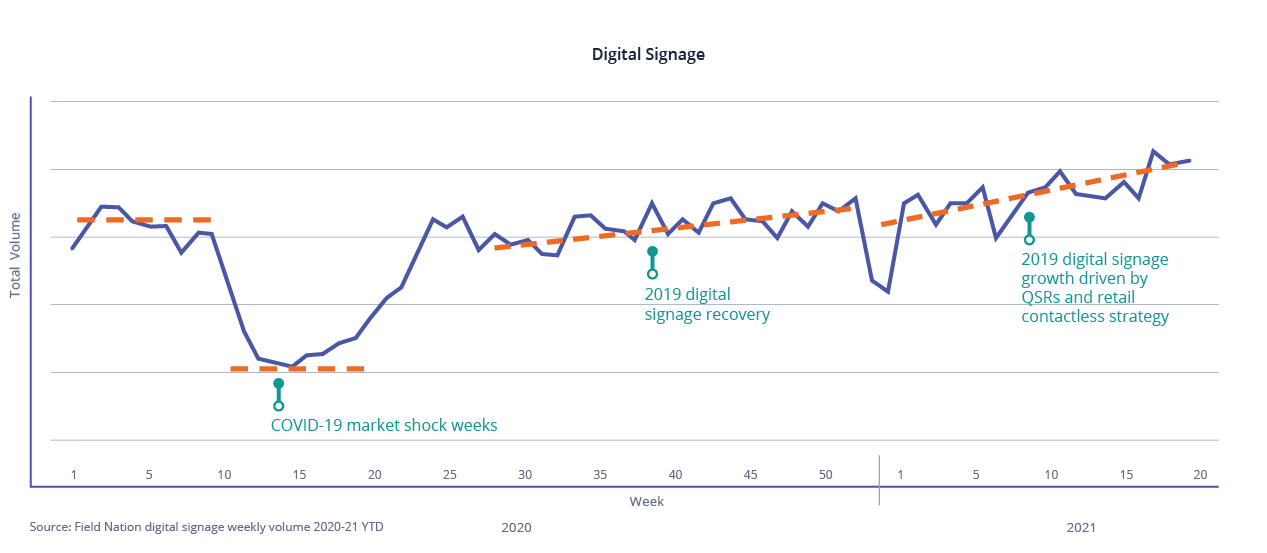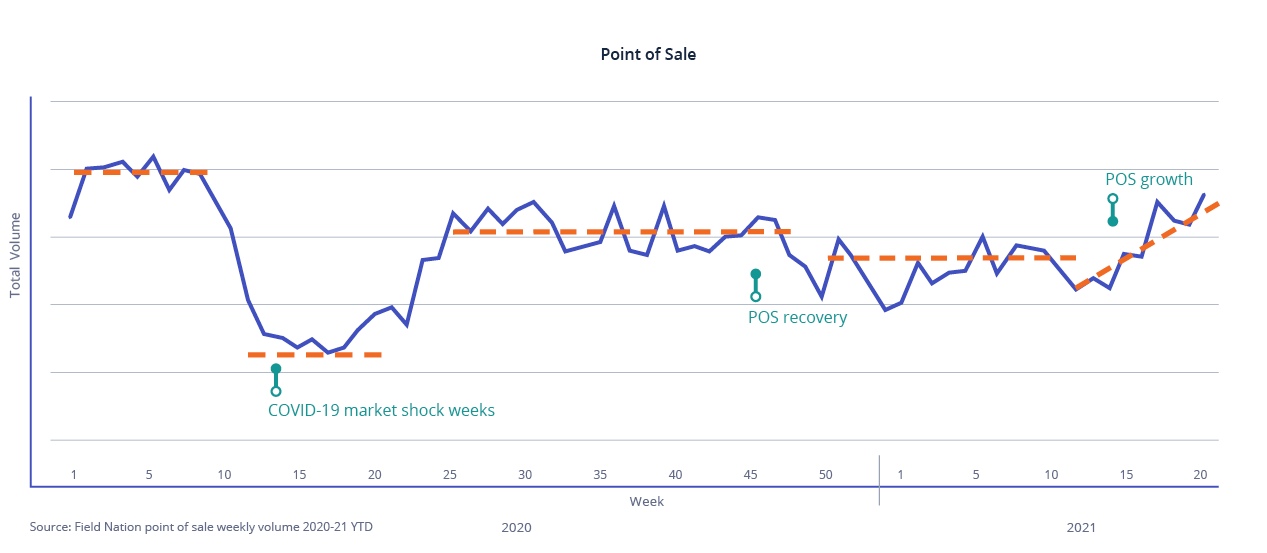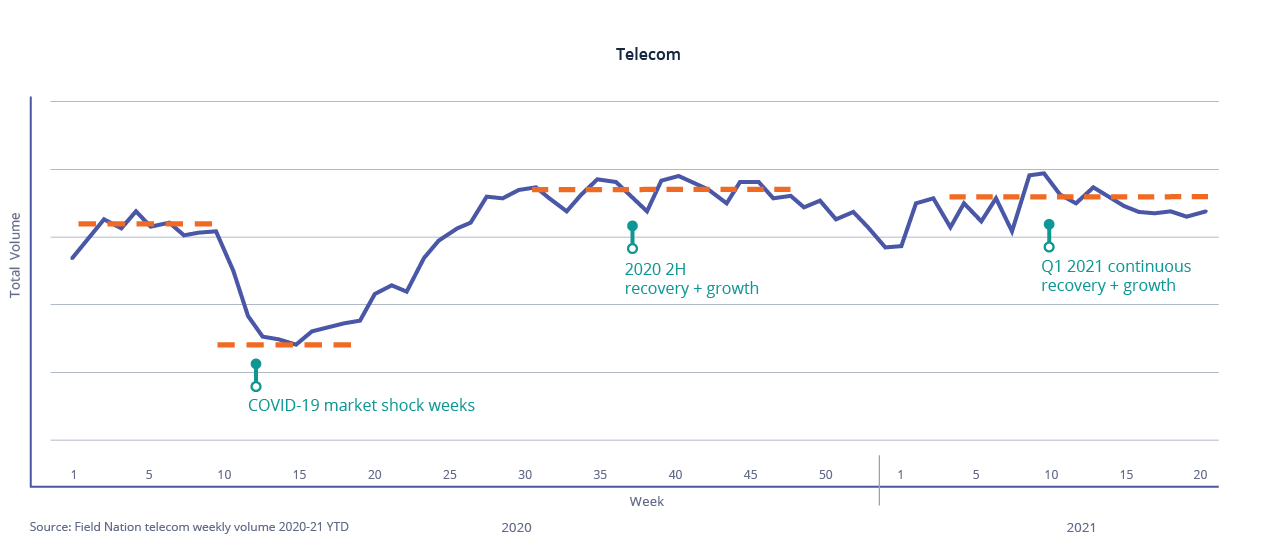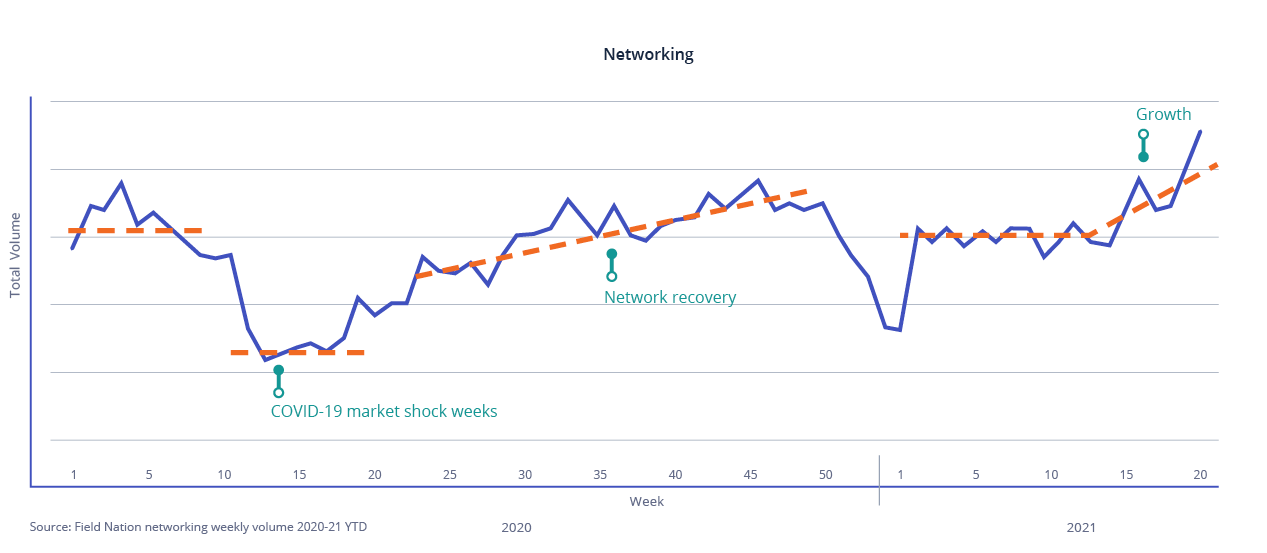Field Intelligence: Riding the field service recovery wave
June 9, 2021
June 9, 2021
By Wael Mohammed, EVP of Product Management
As the world begins to open back up, companies across every industry are adjusting to a post-COVID reality and capitalizing on shifts in technology and consumer behavior.
For service delivery companies, this means that a surge in demand is coming.
Because Field Nation processes over 1 million work orders per year, we are uniquely positioned to spot these trends in the field service ecosystem. Through our field intelligence, we are able to capture shifts in technology spend priorities as they emerge, which gives us insight into where the market is and where it’s headed.
Moreover, this data lets us know which types of work are experiencing the most dramatic surge in demand (and which types of work are experiencing a slower model of recovery).
In this article, I’ll provide a peek behind the Field Nation curtain. By sharing key data points pertaining to service recovery and contextualizing them within broader trends, you’ll see a detailed portrait of how industries are rebounding from COVID-19 and what that means in terms of service opportunity.
The market landscape looks dramatically different than it did a year ago, or even prior to the disruption of COVID-19. Especially in the retail space, the pandemic added fuel to existing trends – some of which may come as a surprise.
Firstly, store openings are outpacing closings.
Even with the COVID-19 pandemic still weighing on physical retail, retailers in the U.S. collectively plan to open 3,344 stores so far this year, according to a recent Coresight Research report. That’s 39.5% more openings than announced at this point last year and also well ahead of the 2,649 closures announced so far in 2021.
A major driver of this is a surplus of available commercial real estate, which has led to favorable lease terms for retailers. Accordingly, retailers are taking advantage of this opportunity to experiment with new formats that may have been too cost-prohibitive in the past.
Secondly, as sales ramp back up, retailers are pouring resources into their in-store experience. Major investments from retail giants like Walmart and Amazon reveal what this transformative, industry-wide spend will look like.
These trends send a clear sign: retailers are ready to incorporate transformative technological investments in their recovery plan, and see the current moment as an opportunity to boldly reimagine their customer’s experience of their brick and mortar locations.
As the people responsible for installing, servicing, and maintaining these new technological investments, service providers are faced with boundless opportunities.
Let’s take a look at how these retail trends match with and are supported by our marketplace data.
Overall, the data trends are positive. The weekly volume of work being posted to the Field Nation marketplace has risen to pre-COVID levels, with our 2021 numbers rising above our 2019 numbers within the last 12 weeks. This number of unique sites that technicians using our marketplace are serving is also outpacing 2019 and 2020 numbers.
This tells us that we are indeed witnessing signs of recovery in the field service space.
However, service types are experiencing varied trajectories. By taking a closer look at how different types of service delivery are recovering, we can anticipate where retail’s upcoming technological spends will be concentrated. Accordingly, service providers can make adaptive plans and make the most of the recovery wave of demand.

Despite an initial slowdown, digital signage is experiencing a robust recovery. A significant contributor to this trend is a shift in spending from full-service restaurants to quick-service restaurants, or QSRs. Generally speaking, more and more retailers are looking to digital signage as a new way to engage their customers and personalize the in-store retail experience. This is why we are predicting that digital signage is here to stay, and presents a major, lasting opportunity for service providers.

We are also seeing a spike in point-of-sale. This corresponds with retailers’ forecasted surge in retail activity as “revenge shopping” (or, an increase in consumer spending after a year of isolating and frugality) takes hold. We are seeing an especially high-level investment in self-checkout and believe that more grocery, pharmacy, and general retailers will continue to move toward this low-friction solution for contactless shopping.

After a relatively quick rebound in 2020, telecom is still in the midst of a steady recovery. While activity in the past few weeks has not been rising as dramatically as digital signage or POS, new investments in 5G connectivity and broadband infrastructure upgrades are keeping demand for telecom services stable. In fact, as certain work from home norms become solidified, we predict that corporations will send an increased number of technicians to employees’ homes to shore up security and delayed maintenance.

All of the other types of technology we’ve discussed so far rely to some degree on networking technology. As you might expect, this has translated into its growth over the past several weeks. As businesses continue to expand their network infrastructure, we expect this sector to continue experiencing growth long after the pandemic has ended.
As companies adjust to shifting demand and new technological imperatives, major shifts in technology spending reveal plans for retail’s future (and present major opportunities for those in the service delivery space). These are a few things service providers can do to prepare for the upcoming surge in demand.
As with all demand surges, the impending surge in demand for technician labor is liable to create capacity issues for service providers of all types. Within the context of this surge, those who can stay agile with their capacity are likely to win the moment. Transitioning from a fixed to a variable labor cost model will open providers up to new market opportunities without adding a great deal of capital investment. Additionally, MSPs should think about optimizing their labor channels to ensure that they aren’t allowing an influx of low-value/high-travel jobs to decrease their margins.
When it comes to putting together RFPs, too many service providers are defaulting to average rates that don’t reflect the variability of rates by geography. Relying too heavily on these averages leads to a lose-lose situation: either you bid too high and lose the deal or you bid too low and lose the margin. By contrast, aligning your bid with location-based rates streamlines the bidding process and boosts speed-to-market, which is more important than ever.
It is natural for service providers to develop niches when it comes to certain types of technology-based service types. However, in order to capitalize on the impending recovery wave, service providers need to be allocating resources to service areas that are showing the most potential for growth. Retailers are looking for new solutions to industry-wide shifts, and your value proposition should be intimately connected to these solutions.
Staying on top of the incoming demand surge will mean making the most of all the information at your disposal. For more industry insights, you can browse our latest Field Intelligence webinars and reports. If you have lingering questions about your specific vertical(s), or if you’re looking for more information about on-demand labor solutions, our team of experts is ready to help.
Field Intelligence expert:
Wael Mohammed has been in the IT services industry for more than 27 years. He has held leadership roles in both startups and large enterprises, including SPS Commerce, IBM, and Target. Wael is currently the Executive Vice President of Product Management at Field Nation and oversees product management, product design, and data science. He is a master in identifying product and market growth opportunities, taking new products to market, and maximizing product performance.
RELATED RESOURCES
Webinar
Join a Field Nation product expert to experience platform features, see real-world applications, and learn first-hand how you can unlock on-demand labor cost, quality, and coverage data to optimize your service delivery.
WebinarBlog
Elevate your field service operations with a technician quality program that prioritizes your customers’ experience and outcomes. Learn from a field service expert as she shares her journey and lessons learned.
BlogBlog
Learn 9 top strategies for effective break-fix projects on the Field Nation marketplace with proven tips from a field service leader.
Blog